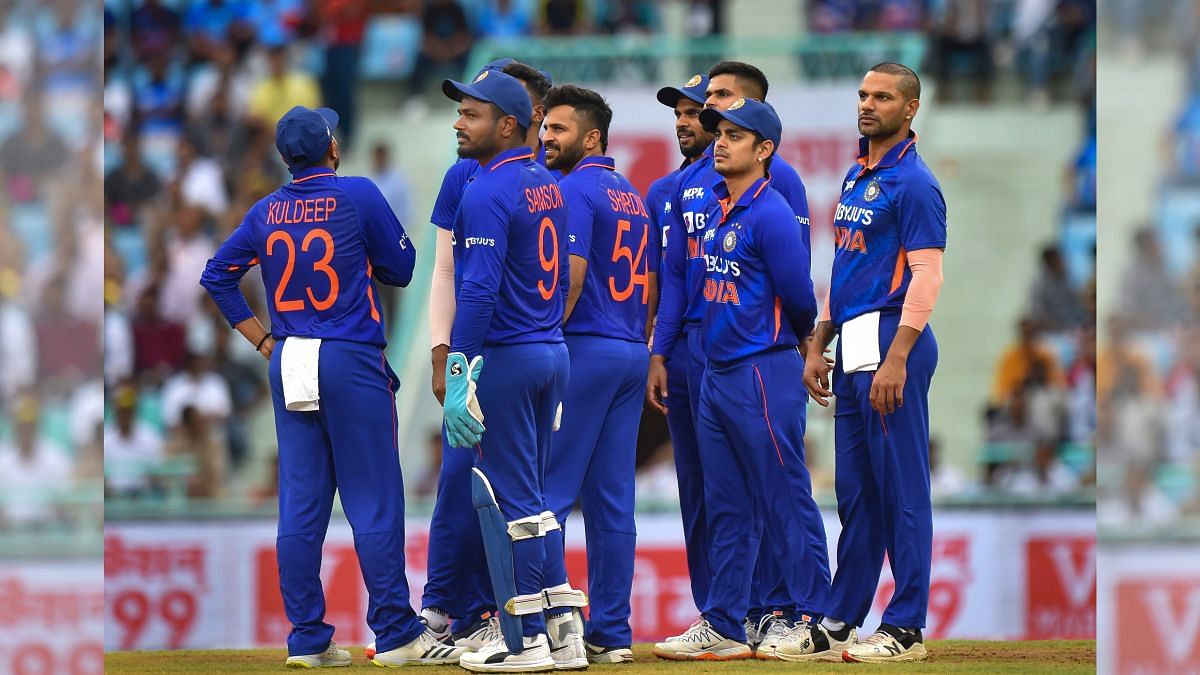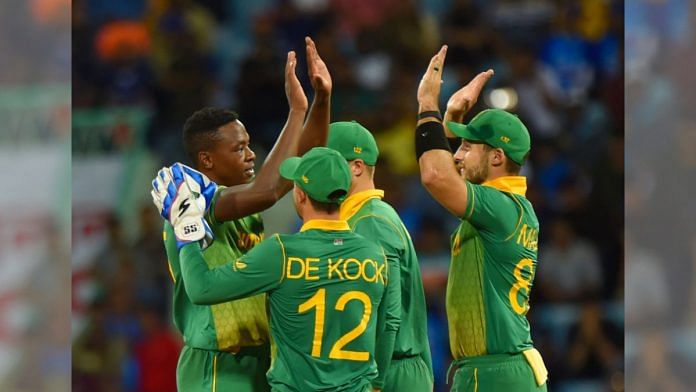New Delhi: India’s preparations for the Men’s T20 World Cup have briefly given way to some ICC World Cup Super League One Day Internationals (ODI) this week, to determine qualifying places for next year’s ODI World Cup.
The first of this three-match ODI Super League series between India and South Africa at Lucknow’s Ekana Cricket Stadium Thursday faced the threat of a washout in the afternoon. But following a two-hour rain delay, a 40-over encounter for each side took place and concluded with the visitors, South Africa, defeating a second-string India side by 9 runs.
The win takes South Africa 10 points closer to the automatic qualification spots in the Super League table, and to avoid the prospect of playing in the World Cup Qualifier tournament in Zimbabwe next summer.
ThePrint takes a look at some key talking points.
1. Klaasen and Miller put the pressure on
Following a steady opening stand by Janneman Malan and Quinton de Kock, India had done well to cause the Proteas to stumble to 110-4 by the 23rd over, thanks largely to Shardul Thakur’s cross seamers and Kuldeep Yadav’s prodigious turners. However, they had no answer for Heinrich Klaasen and David Miller — who more than doubled the Proteas team score by recording a 139-run partnership in 17.4 overs. While Klaasen relied on his sweeps and reverse sweeps to good effect, Miller continued his blistering form by once again showcasing his strong power game from ball one.

2. India top order can’t handle Proteas seam threat
One of the bigger disappointments for India’s depth ahead of next year’s ODI World Cup was how the stand-in top order looked all at sea against South Africa’s seam bowling trio, but particularly the opening bowlers in the 8-over powerplay. Neither Kagiso Rabada nor Wayne Parnell extracted a great deal of swing in the weather conditions at Lucknow but induced just the right amount of movement off the seam to keep Shubman Gill, Shikhar Dhawan and Ruturaj Gaikwad guessing. Gill was punished early by Rabada for a loose drive, Parnell frustrated Dhawan with his disciplined lengths and seam movements before inducing a tame shot, while Gaikwad was beaten several times by Rabada’s pace and only hit a single boundary in his 42-ball innings of 19.
3. Iyer blitz cut short by usual technical frailties
With India reeling at 51-4 in the 18th over and the required run rate rising above 9, Shreyas Iyer was the first to give the innings a much needed impetus with a quick-fire half century. In doing so, Iyer began targeting boundaries from early on off the bowling of Tabraiz Shamsi in particular, but he also took risks against better bowlers of the night like Parnell and Lungi Ngidi. A particularly strong period was in the 21st over, when he brought out the slog sweep, swift feet movement and a generally strong reading of wrist spin to smack three consecutive boundaries off Shamsi’s bowling. However, Iyer’s glaring historical technical weakness has been his tendency to “dance” around the crease when facing short balls from pacers. This issue halted his innings on Thursday night as well, as he lost his shape when attempting to play a pull shot to an Ngidi bouncer, breaking a 67-run partnership he had built with wicketkeeper Sanju Samson.
4. Samson and Shardul nearly replicate Klaasen-Miller heroics
After the loss of Iyer in the 27th over, the match looked set for an early finish as the required run rate reached close to 10 with half the Indian side dismissed and still short of 133 runs, but wicketkeeper Sanju Samson and allrounder Shardul Thakur had other ideas. Not only did the duo take a page from the Iyer playbook by going after Shamsi who was having an off day, but they also kept the scoreboard ticking against the seamers before getting in a few boundaries at the death. Thakur fell to an Ngidi full delivery outside off stump with a mistimed slice after smacking Rabada to all parts in the previous over, while Samson smashed three fours and a six in a brutal final over to reduce the gulf between the two teams’ scores and turn Shamsi’s figures from bad to catastrophic.
5. Ever-reliable Keshav Maharaj puts the squeeze on
If South Africa qualify for the World Cup automatically upon the completion of their remaining seven Super League ODIs, they will probably have left-arm spinner Keshav Maharaj to thank, more so than the other bowlers. Having established himself in the side enough to be named the stand-in captain for some of South Africa’s matches earlier this year, Maharaj has developed a reputation for being hard to score off due to his disciplined lines and clever tactical decision-making. These abilities were on show again in Lucknow as Maharaj conceded just a single boundary in his 8-over spell, with the remainder of his 23 runs conceded coming off singles or the odd wide. As such, Maharaj varied expertly between his stock ball, his shorter flatter deliveries and the occasional flighted delivery to extract a bit more turn before getting his reward with the wicket of Ishan Kishan, a sequence which would not have looked amiss in a Test match.
6. India missed a trick by picking bishnoi over better options
Arguably the biggest misstep from a selection point of view for India is basing some of this stand-in ODI squad off rior T20I and IPL experience, as opposed to domestic One-Day stats, be it the Vijay Hazare trophy or English county cricket. This poor thinking appeared most evident with the decision to hand an ODI debut to Ravi Bishnoi. The leg spinner has had an exemplary start to life in the shortest format with Punjab, Lucknow and India but his List A stats prior to his debut are terrible on all counts, averaging over 35 with an economy rate of more than 5.50. It is a particularly baffling selection when the likes of Rahul Chahar, who averages less than 26 with an economy of just above 5, have been waiting in the wings. As a result, Bishnoi had a largely forgettable debut, conceding 7 fours and 1 six in his 8-over spell, despite having claimed Quinton de Kock as his first ever ODI wicket.
7. India’s amateurish dropped catches on show
The worst moments from an Indian perspective in the first ODI, however, was some of the standards of fielding, or lack thereof. Janneman Malan was given a lifeline at the end of the powerplay when Gill grassed a regulation catch off Thakur’s bowling, but the greatest profligacy was shown in the 38th over. Miller and Klaasen had already built up their innings-saving partnership but still needed that final push to elevate the team score from competitive to match-winning. Avesh had endured a decent night with the ball and was unlucky to have gone wicketless in the opening powerplay, but was especially hard done by in his final over. First he bowled a slot ball outside off stump inducing Klaasen into playing across the line and top edging a delivery sky high but Mohammad Siraj shelled the catch. The very next ball Miller attempted a pull shot and didn’t connect well enough but Bishnoi showed poor match awareness and failed to get anywhere near the ball to catch it. What could have been two wickets in two balls for Avesh instead resulted in 5 runs out of a 16-run over.
8. Proteas captain Bavuma fails again
While the Proteas can celebrate a rare narrow ODI win in what has been a poor Super League campaign, the big question mark both for the Men’s T20 World Cup in Australia and for their long term ODI future is the terrible form of captain Temba Bavuma. Having missed the entirety of South Africa’s all-format away tours to England and Ireland due to an elbow injury and going unsold in the auction of the upcoming South African T20 franchise league, Bavuma returned to action with 2 ducks, a single-digit score and over a dozen dot balls in the recently concluded T20I series. The captain then continued this horrid run in Lucknow with a score of just 8 off 12 balls, having scored two boundaries while the rest of his innings were dot balls. Although Bavuma’s career stats in Tests and ODIs remain impressive amid this spell, his T20I stats have gone from bad to worse, and look especially bleak given that his presence at the top of the order is keeping the far more impressive Reeza Hendricks out of the side. If South Africa want to win the Men’s T20 World Cup next month, they may have to consider a ruthless pulling of the trigger, from both the limited overs captaincy and batting selection standpoint.
Also read: Not easy at all, ball was moving around: Klaasen



